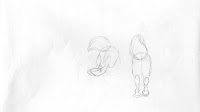 |
| Help! I'm A Fish movie poster (2000) |
The movie is about three kids who are transformed into fish by drinking a magic potion invented by a crazy scientist. The girl, Stella, who is turned into a starfish, befriends a small seahorse. At the end of the movie when the kids become human again, the seahorse is magically transformed into a real horse.
The horse was supposed to resemble the fairly cartoony seahorse, so we weren't going for a very realistic look. Yet, in order to make it believable, it had to move somewhat like a real horse. So how to go about it? As it happened, I knew where to look.
 |
| Sasha the seahorse |
When I worked on Don Bluth's All Dogs Go To Heaven in 1988 all the animators were given a big, fat folder with xeroxes of pictures of humans and animals in motion photographed by the legendary Eadweard Muybridge. The photos were taken in the 1870's using a system of wires that the objects (people, horses and other living creatures) would trip one at the time, triggering a series of cameras strategically placed so as to capture each part of the movement. Mind you, this was done before moving pictures were even invented! The idea was for us animators to study the movements of all kinds of creatures, especially dogs, as we were doing a dog movie.
A series of Muybridge's photos of a horse galloping is shown below.
Muybridge's series perfectly depicts the position of the horse's body and legs on each frame. So I registered copies of the pictures on animation paper so they would work as an animation cycle of the horse galloping.
Even though the pictures were presumably taken without a specific frame rate in mind (the general frame rate of 24 FPS was only fixed with the emergence of sound films in the 1920's) the cycle seemed to work "on ones," i.e. one picture per frame of film at 24 FPS.
In order to gain some clarity over the relatively complex leg movements, I traced over the pictures for a drawn version of the cycle. On top of this realistic horse I then drew the caricatured cartoon horse version of Sasha. Finally, in order to make it even more cartoony, I caricatured the movement itself by having her jump higher at every stride.
Most of our animation in those days were "on twos," i.e. every drawing would be held for two frames of film. But in order to capture the detail in the horse's leg movement it was necessary to work "on ones," that is, have a unique drawing for every single frame of movement. The only exception is during the "weightless moment" when the horse is flying in the air without ground contact.
The video below shows the progress through the stages from Muybridge's series to the final Sasha horse gallop cycle.
Modelsheet showing how to animate the gallop for Sasha the horse:
And here is the final result in color. In the end I only animated about six seconds of the horse galloping. In addition, a good part of it ended up covered in smoke. What you gonna do. A brilliant exercise though and good fun!
Part II - Asterix Horses
My next, and thus far only other, encounter with horse animation occurred in 2004 on the Danish/French animated feature Asterix And The Vikings (released 2006). Justforkix, the teenage nephew of chief Vitalstatistix, spends the summer at the Gaulish village in order to learn how to be a man. The mission fails miserably and (the vegetarian and pacifist) Justforkix leaves the village in the middle of a row between Asterix and his life-long friend Obelix.
In the particular shot we see Justforkix racing away in his fancy two-horse chariot. So I developed a cycle of the two horses galloping, seen from the back, once again based on Muybridge's old photos. These are the individual drawings that make up the 12 frames cycle (on ones).
The video below shows a linetest of the cycle of the two horses galloping in place (cycled 10 times) followed by the same animation inserted into the background layout and zoomed to match the layout's perspective.
And here's a clip from the final color movie showing the end result. The scenes of Asterix and Obelix preceding the horse shot are animated by Doron Meir. The actual horse shot is only 32 frames long. On top of the horses a CGI animation layer of Justforkix' chariot carrying a huge menhir (a stone given to him by Obelix) is added as well as a 2D-animated layer of dust.
As you can see, once again, the painstakingly hard work of animating the horses is mostly covered up by other stuff. Apparently that's the fate of the horse animator. Or maybe I just need to take a hint ;)


























No comments:
Post a Comment